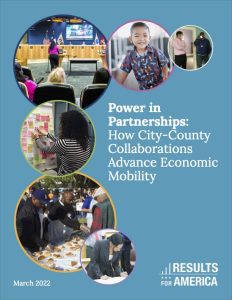 Growing economic inequality and disparities of opportunity are among the great challenges of our time. Addressing these systemic challenges requires new and innovative solutions. Cities and counties have an important role to play: individually they oversee most of the services that residents interact with on a day to day basis. Working together, they have the power to significantly improve the lives of residents and address inequality by compounding their own jurisdictional authorities and finances, and finding efficiencies in ways that can expand any individual impact they could have. Results for America carried out research that identifies best practices for city-county collaborations, developed six case studies of interjurisdictional collaboration, and highlighted how local governments can work together to advance economic mobility.
Growing economic inequality and disparities of opportunity are among the great challenges of our time. Addressing these systemic challenges requires new and innovative solutions. Cities and counties have an important role to play: individually they oversee most of the services that residents interact with on a day to day basis. Working together, they have the power to significantly improve the lives of residents and address inequality by compounding their own jurisdictional authorities and finances, and finding efficiencies in ways that can expand any individual impact they could have. Results for America carried out research that identifies best practices for city-county collaborations, developed six case studies of interjurisdictional collaboration, and highlighted how local governments can work together to advance economic mobility.
Many policy, infrastructure, and program areas that cross jurisdictional boundaries lend themselves to more regional solutions and thus require collaboration. Some of these areas include: childcare and early childhood education; affordable housing and homelessness; workforce development; digital inclusion and broadband access; transportation; and disaster response and planning. City and county leaders should communicate and align efforts around these areas as they seek to address inequities and improve the lives of residents.
Six case studies were created from across the U.S. to exemplify and detail city-county collaborations that improved economic mobility. The following cities and counties were selected:
- City of San Jose & Santa Clara County, CA: Collaborating to End Homelessness
- City of Cincinnati & Hamilton County, OH: Child Poverty Collaborative & Project LIFT
- City of Savannah & Chatham County, GA: The Front Porch, Alternative to Justice System Involvement
- City of Memphis and Shelby County, TN: Pre-K for All
- City of Los Angeles and LA County, CA: Performance Partner Pilot (P3) Initiative for Disconnected Youth
- City of Seattle and King County, WA: COVID-19 Vaccine Distribution
Key Findings
-
- Most collaborations go beyond just a city and a county. They are often sustained by third-party intermediaries. This includes community-based partners present at the beginning of the work or brought in as sustaining partners.
- The nature of collaboration changes over time. The tools needed at the beginning are different from those needed to sustain and expand.
- People have to work together for organizations to collaborate. This process teaches individuals how other entities operate, revealing future partnership opportunities.
- Cities and counties often fail to capture best practices and tools, limiting the ability to replicate successes elsewhere or in other policy areas.
- Staff motivated to increase economic mobility often collaborate across governments in spite of systemic barriers.
- Many city-county collaborations involve a third party that acts as a bridge, contributing ideas, human resources, and specific skills (e.g., project management) to the initiative. These intermediaries can be integral to sustaining successful collaborations in part because they can help overcome various barriers that often prevent or inhibit city-county collaborations.
- Common barriers that often prevent or inhibit city-county collaborations include competing priorities and interests; competition to attain funding; political tensions; and a lack of staff capacity.
- Incentives that can facilitate collaboration between cities and counties include state and federal mandates, grant-based incentives, constituent demand, and crises (such as COVID-19).
- Internal forces can inspire collaborative initiatives, such as budgetary constraints, a desire for greater effectiveness, and strong support from elected officials.
In the face of significant barriers, city and county staff and elected leaders, as well as community-based organizations, are coming together to increase the economic mobility of residents. The reason is simple: Local governments and communities recognize that they can power greater change by working together.